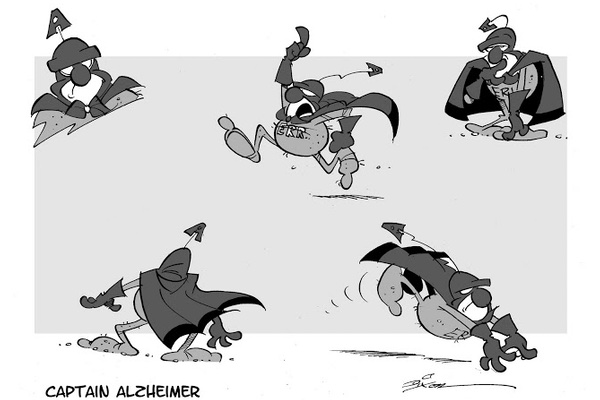By Karl Dixon
Read Part 1, Part 3, and Part 4
My first post dealt with my comic character Captain Alzheimer from a rough sketch to fully fleshed-out character. For this post, I’ll be drawing Captain Alzheimer in a variety of poses. I do this purely to see how versatile he can be, how he looks from different angles and performs with different emotions.
Below is a typical example of one of my character sheets. Some cartoonists use these sheets as reference, some use them for warming up. I personally don’t do either as I’ve never felt the need to warm up–I just like to get straight to it, and once I’m into drawing the character, I tend to throw these pages away.
Action is significant, so even when Captain Alzheimer is standing still (top right) he’s still showing signs of action–bent knees, pondering finger at the mouth, and movement of his cape. Also you may note how the capital “A” above his head accentuates his movement; if he’s moving fast the “A” is stretched behind him. If he’s surprised, it could be poinging straight up; or when he’s looking confused or dejected, it could hang low. And finally, and for this character in particular, I needed to see how his cape would affect his movement. The cape in a super hero is almost like a supporting actor and can aid greatly to a panel’s mood.
Speaking of supporting actors, the next thing I needed to do was create Captain Alzheimer’s immediate supporting cast. But first, I needed to finalize the idea for strip–I had to create a world for them to live in. A world which would continue to inspire storyline after storyline, very important if you want your idea to run past the first few weeks.
When creating a character, you must consider your market. If you’re looking to syndicate a comic strip, then you want pink and fluffy things. If it’s political, then the character or idea needs to be more hard-hitting, angular, less fluffy.
In this case, the market I was targeting was for over the top humour–strips that took on adult themes through the medium of a children’s-style comic format, but a format that most definitely was not for children. So the idea of a pompous superhero who kept forgetting things seemed like potential for a strip my targeted market would be interested in. And deciding to have him run around in his thermal underwear and a towel because he could remember to change, but couldn’t remember what he’d done with his costume, made me realise I was on to something.
The other characters in this strip needed to be at a minimum and serve mainly to offset his ever-confusing activities. So I drew the characters below:
His wife, who is very calm, tries to convince him that he’s no longer a superhero and to stay indoors where it’s safest. She also seeks respite care, and this causes more fun when he tears around the day centre causing even more confusion–seeing the nurse as a super villain called Miss Matron or the psychiatrist as Dr Psychobabble, the evil-minded controller.
The next character was the Police sergeant who Captain Alzheimer refers to as the commissioner; as Batman might to his police contact. The sergeant is a frustrated character juggling budgets with crime figures, ever more increasing pressure groups and a total lack of faith by the public in the system of law. Now, it would seem, he has to deal with an idiot in long johns and a towel who thinks he needs him to solve the cities crime wave. So the cartoon has a socio political theme along a silly side.
I hope you’ve enjoyed the second of my posts and are gaining more of an insight into how a comic is formulated. Not all cartoonists use the exact same formula, but as a guide it will work very well for the aspiring cartoonist. Next week we’ll be exploring how a character is put together in stages. I’ll also be showing you how I apply the gray shading on him in Photoshop.





I love your work! It is all your own, and original, but it reminds me a little of Asterix the Gaul, by Goscinny and Uderzo…you have the same subversive humor 🙂
Thanks for the information, and these supporting characters are great!